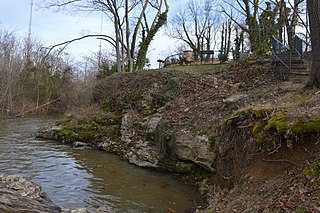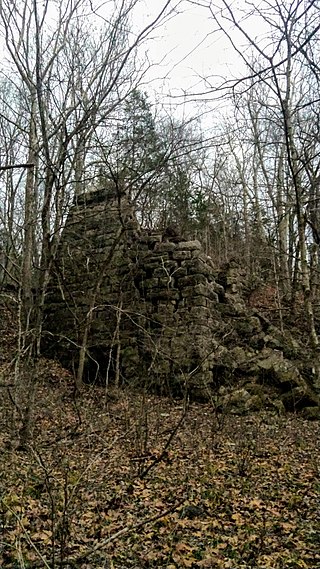
The Tredegar Iron Works in Richmond, Virginia, was the biggest ironworks in the Confederacy during the American Civil War, and a significant factor in the decision to make Richmond its capital.

The Cape Henry Lighthouses are a pair of lighthouses at Cape Henry, the landform marking the southern entrance to Chesapeake Bay in the U.S. state of Virginia. The location has long been important for the large amount of ocean-going shipping traffic for the harbors, its rivers, and shipping headed to ports on the bay. The original lighthouse was the first authorized by the U.S. government, dating from 1792. It was also the first federal construction project under the Constitution, for an original contract amount of $15,200. A second lighthouse was built and completed in 1881 a short distance away after concern arose about the stability of the first. Both towers of the light station were designated a National Historic Landmark in 1970.

Coopers Rock State Forest is a 12,747-acre (52 km2) state forest in Monongalia and Preston counties in the U.S. state of West Virginia. Its southern edge abuts Cheat Lake and the canyon section of Cheat River, a popular whitewater rafting river in the eastern United States.

Falling Creek Ironworks was the first iron production facility in North America. It was established by the Virginia Company of London in Henrico Cittie (sic) on Falling Creek near its confluence with the James River. It was short-lived due to an attack by Native Americans in 1622.

Longdale Furnace is an unincorporated community located east of Clifton Forge in Alleghany County, Virginia, United States.

The Clinton Furnace, also known as the Clinton Ironworks, is located along Clinton Road at the base of the Clinton Reservoir by the Clinton Brook in the township of West Milford in Passaic County, New Jersey, United States. The furnace was built in 1826 and was added to the National Register of Historic Places on June 18, 1976, for its significance in industry. The furnace is the last surviving structure of the iron community once known as Clinton.

The Reading Furnace Historic District is a national historic district that is located in Warwick Township and East Nantmeal Township, Chester County, Pennsylvania.

Mt. Torry Furnace, also known as Virginia Furnace, is a historic iron furnace located at Sherando, Augusta County, Virginia. It was built in 1804, and is a stone square trapezoid measuring 30 feet at the base and 40 feet tall. The original cold-blast charcoal stack was converted for hot blast in 1853. It shut down in 1855, then was reactivated in 1863 to support the Confederate States Army. The furnace was destroyed in June 1864 during the American Civil War by Brigadier General Alfred N. Duffié, then rebuilt in January 1865. It operated until 1884.

Callie Furnace is a historic iron furnace located near Glen Wilton, Botetourt County, Virginia. It was built as a hot-blast charcoal furnace around 1873–1874, and subsequently enlarged and converted into a coke furnace. In 1883, the stack was raised an additional five feet, and a tuyere was added. Callie Furnace went out of blast in 1884.

West Fork Furnace is a historic iron furnace and national historic district located near Floyd, Floyd County, Virginia. The district includes structural, landscape and archaeological components of a small and well preserved mid-19th-century iron furnace built about 1853. The components consist of the furnace, retaining wall, staging area, head race, wheel pit, tail race, and East Prong of Furnace Creek. The furnace remained in operation until 1855.

The Farm is a historic home located at Rocky Mount, Franklin County, Virginia. The house was probably built during the late-18th century, expanded in the 1820s, and heavily remodeled in the Greek Revival style around 1856. It is a two-story, frame dwelling sheathed in weatherboard with a single-pile, central-passage-plan. It features a two-story, projecting front porch. Later additions were made in the late-19th and early-20th century. Also on the property are a contributing one-story brick slave quarters/summer kitchen and the site of a farm office marked by a stone chimney. The house was used as the ironmaster's house for the nearby Washington Iron Furnace.

Washington Iron Furnace is an historic iron furnace, located in Rocky Mount, Franklin County, Virginia. The granite furnace was built around 1770, and measures 30 feet high on its south face. It helped establish industry in the county, and was listed on the National Register of Historic Places in 1973.

Old Forge Farm, also known as Zane's Furnace, Stephens Fort, and Marlboro Iron Works, is a historic home and farm located near Middletown, Frederick County, Virginia. The original section dates to the 18th century. The house is a two-story, asymmetrical, three-bay, limestone dwelling with a two-story addition connecting the main house to a one-story former summer kitchen. Also on the property are the contributing 18th century hexagonal ice house of unusual design, an early 20th-century root cellar, privy, and shed. The property was first known as Stephen's Fort, built by Lewis Stephens, son of Peter Stephens, for protection during the French and Indian War. Sold in 1767 to Isaac Zane, whose Zane's Furnace was a major manufacturer of munitions for the Continental Army. Grist mill operations continued into the 1950s.

Saltville Battlefields Historic District is a historic American Civil War battlefield and national historic district located around Saltville, in Smyth County and Washington County, Virginia. The district includes 3 contributing buildings, 31 contributing sites, 4 contributing structures, and 1 contributing object near Saltville. It encompass the core areas of two battles, fought on October 2 and December 20, 1864, known as the Battle of Saltville I and Battle of Saltville II, where Confederate and Union forces contested control of the South's most important salt production facilities. Notable resources include the sites of salt furnaces, Well Fields, Fort Statham, Lover's Leap Defenses, Saltville Gap Overlooks, Mill Cliff gun emplacements, Fort Breckinridge, Fort Hatton, Sanders’ House/Williams Site Battlefield/field hospital, William A. Stuart House, and the Elizabeth Cemetery.
Accokeek Furnace Archeological Site is a historic archaeological site located near Stafford, Stafford County, Virginia. The Principio Company of Cecil County, Maryland, constructed the Accokeek Iron Furnace about 1726 on land leased from Augustine Washington, father of George Washington. After his death in 1743, his son Lawrence Washington inherited his interest in the company and furnace. When he died in 1752, his share descended to his brother Augustine Washington Jr. Operations at this site ceased around 1753. A historical marker denoting this site is located on the grounds of Colonial Forge High School.

Foster Falls Historic District is a national historic district located near Max Meadows, Wythe County, Virginia. The district encompasses 12 contributing buildings, 2 contributing sites, and 3 contributing structures in the village of Foster Falls. They are primarily industrial and commercial buildings and structures built in the late-19th century. They include the iron furnace stack, the rail bed and frame railroad passenger station, a general store building, and a combination gristmill/sawmill. The district includes the Foster Falls Hotel, a late-Victorian style brick building. The hotel property includes two brick dependencies associated with an orphanage that occupied the hotel building beginning in 1938. It now serves as the headquarters of the New River Trail State Park.

Roaring Run Furnace is a historic iron furnace located in Jefferson National Forest near Eagle Rock, Botetourt County, Virginia. It was built about 1832, and reflects the national and statewide economics of the iron industry during the 19th century.

The Tubal Furnace Archeological Site is the site of an early 18th century industrial iron works in Spotsylvania County, Virginia, near Chancellor. Established by colonial Lieutenant Governor Alexander Spotswood in c. 1717, the site included a furnace and waterworks. It was operated, primarily by skilled slave labor, into the early 19th century.

Scotia Iron Furnace Stack is a historic iron furnace stack located near Leasburg, Crawford County, Missouri. It was built about 1870 by the Scotia Iron Works, and is 35 feet wide at the base, and approximately 40 feet high. It is constructed of native limestone blocks. The furnace remained in operation until 1880.
Moselle Iron Furnace Stack is a historic iron furnace stack located near Moselle, Franklin County, Missouri. It was built in 1848-1849 by the Moselle Iron Furnace (1850-1854), and later operated as the Furnace of the Franklin Iron Mining Co. (1855-1859), and Moselle Iron Company (1874-1875). It is 31 feet high and constructed of cut stone blocks. The furnace was closed in early June 1875.






















